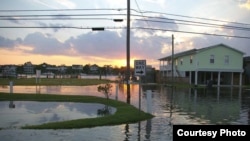Ocean levels are rising faster and higher on both coasts of the United States than in other parts of the globe, according to two new studies, and California could be especially hard hit.
“There will be about one meter of sea level rise by 2100," says Johns Hopkins University civil engineering professor Robert Dalrymple, chair of the academic panel that produced the report. "This is higher than what the IPCC [Intergovernmental Panel on Climate Change] had estimated.”
Melting ice from glaciers, ice sheets and ice caps account for 65 percent of sea level rise. Expansion of the world’s oceans as they warm makes up the rest.
California was one of three states on America’s Pacific coast - along with Oregon and Washington - to ask the National Research Council to study how changes in sea levels would affect them.
The IPCC's estimate of global sea-level rise was released in 2007. Based on that report and studies since then, Dalrymple sees two major effects.
“One is that as the sea level rises, it inundates low-lying area," he says. "And then the second major issue is because the sea level is higher, when there are coastal storms, then they reach further inland. The damage due to coastal storms will increase."
As the climate warms, more extreme storm surges and high waves are expected, raising the risk of flooding, coastal erosion and wetland loss. Up and down the California coast, highways, sports stadiums and housing developments are only a meter or so above the highest tides.
San Francisco International Airport would flood with 40 centimeters of sea level rise, a likely scenario within a few decades, according to the report.
While the outlook for Washington and Oregon is a bit brighter, Dalrymple says a powerful earthquake could raise sea levels dramatically.
“And that will cause the sea level rise in those two states, comparable to what 100 years of sea level rise would do, except it would be a very dramatic happening in minutes. So as the land drops a meter or two, that is like one or two meters of sea level rise.”
That would be in addition to the 60-centimeter rise already predicted over the next century, due to global warming, Dalrymple says.
Sea level rise also threatens the U.S. east coast. A United States Geological Survey (USGS) study looked at a 1,000-kilometer stretch of America’s Atlantic seaboard, from Massachusetts down to North Carolina.
The area had already been labeled a “hotspot” for sea level rise but the outlook could be even worse than the experts thought.
“Over a 60-year period, the rates within that hotspot area have increased between two and 3.7 millimeters per year," says USGS oceanographer and lead author, Asbury Sallenger. "An increase like that is three to four times greater than you find in the average increase in rate of sea level rise over the same period.”
The report finds the sea-level rise on the East Coast is consistent with a slowdown in the circulation of the Atlantic Ocean. Computer models show a change in circulation may be tied to changes in water temperature, salinity and density in the sub-polar north Atlantic.
“A slowdown of the circulation actually can lead to changes in currents that run along the eastern seaboard in a way that translates to increasing sea level in the northeast United States,” Sallenger says.
He hopes data from the two coastal studies will be useful tools that help public officials and ordinary citizens better respond to the looming challenges posed by global climate change.
“There will be about one meter of sea level rise by 2100," says Johns Hopkins University civil engineering professor Robert Dalrymple, chair of the academic panel that produced the report. "This is higher than what the IPCC [Intergovernmental Panel on Climate Change] had estimated.”
Melting ice from glaciers, ice sheets and ice caps account for 65 percent of sea level rise. Expansion of the world’s oceans as they warm makes up the rest.
California was one of three states on America’s Pacific coast - along with Oregon and Washington - to ask the National Research Council to study how changes in sea levels would affect them.
The IPCC's estimate of global sea-level rise was released in 2007. Based on that report and studies since then, Dalrymple sees two major effects.
“One is that as the sea level rises, it inundates low-lying area," he says. "And then the second major issue is because the sea level is higher, when there are coastal storms, then they reach further inland. The damage due to coastal storms will increase."
As the climate warms, more extreme storm surges and high waves are expected, raising the risk of flooding, coastal erosion and wetland loss. Up and down the California coast, highways, sports stadiums and housing developments are only a meter or so above the highest tides.
San Francisco International Airport would flood with 40 centimeters of sea level rise, a likely scenario within a few decades, according to the report.
While the outlook for Washington and Oregon is a bit brighter, Dalrymple says a powerful earthquake could raise sea levels dramatically.
“And that will cause the sea level rise in those two states, comparable to what 100 years of sea level rise would do, except it would be a very dramatic happening in minutes. So as the land drops a meter or two, that is like one or two meters of sea level rise.”
That would be in addition to the 60-centimeter rise already predicted over the next century, due to global warming, Dalrymple says.
Sea level rise also threatens the U.S. east coast. A United States Geological Survey (USGS) study looked at a 1,000-kilometer stretch of America’s Atlantic seaboard, from Massachusetts down to North Carolina.
The area had already been labeled a “hotspot” for sea level rise but the outlook could be even worse than the experts thought.
“Over a 60-year period, the rates within that hotspot area have increased between two and 3.7 millimeters per year," says USGS oceanographer and lead author, Asbury Sallenger. "An increase like that is three to four times greater than you find in the average increase in rate of sea level rise over the same period.”
The report finds the sea-level rise on the East Coast is consistent with a slowdown in the circulation of the Atlantic Ocean. Computer models show a change in circulation may be tied to changes in water temperature, salinity and density in the sub-polar north Atlantic.
“A slowdown of the circulation actually can lead to changes in currents that run along the eastern seaboard in a way that translates to increasing sea level in the northeast United States,” Sallenger says.
He hopes data from the two coastal studies will be useful tools that help public officials and ordinary citizens better respond to the looming challenges posed by global climate change.











